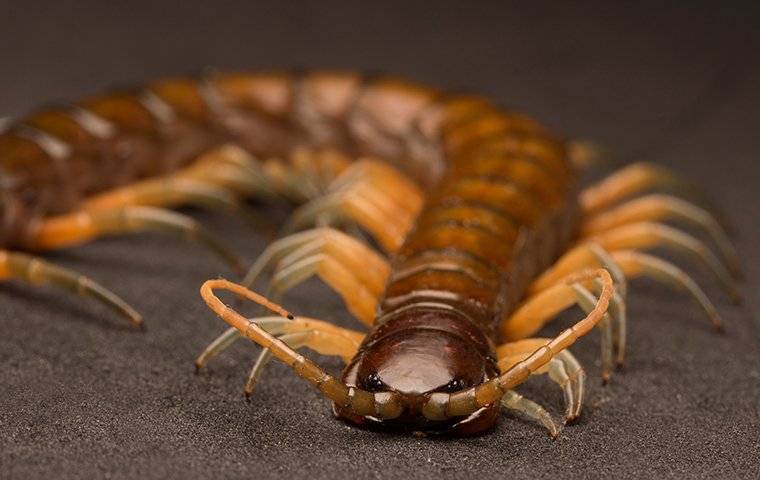
Centipedes
What Are Centipedes?
While not every class of centipede has precisely one hundred feet, there are many fascinating foot-related actualities within this family. Centipedes are best known for the cause of their name, which interprets from Latin as, ‘hundred foot.’ Numbers may fluctuate somewhere in the range of 20 sets to more than 300 arrangements of legs…that is an incredible 600 feet, for those checking! The legs shift according to which centipede; the short legs are at the front of the body and the longest at the back.
Most centipedes found around buildings rarely measure more than 2 inches. In Texas and the desert southwest, however, a couple of species can measure 6 inches or more and can wander in homes and other buildings. The color also varies depending on the species. Most are brown or brownish-orange, while the great Texas species has a bluish-black body, orange-red head, and yellow legs.
Description

Centipedes are predators that live in the wetlands. These nocturnal creatures hunt insects and spiders at night. They are quite similar to the millipedes, with the difference being that they have only one pair of legs per body segment, while millipedes have two pairs of legs per body segment. They are rarely seen inside homes, except for the house centipede that can breed in vacant spaces and cellars. The house centipede is recognized for its extremely long legs.
Centipedes are fundamental in many gardens crosswise over America, Europe, and Asia. Centipede sightings have even been accounted for in forsake or drier locales, however, they also regularly flourish in wet, soggy territories. Spaces that have thick, wet soil are perfect, as are heaps of leaves that provide the ideal concealing spot to this creepy crawlies. Zones that have high mugginess may likewise observe bigger populaces of the regular house centipede.
Centipedes are predators and are interestingly adjusted for deft chasing. They eat a staggering cluster of creepy crawlies and little vertebrates. Bigger species might be more eager, eating up small fowls, bats, reptiles, and frogs. Disregarding normal misinterpretations, these animals do not eat plants.
Outdoors, centipedes stay in moist protected areas such as landscape mulch and under articles in contact with soil. Inside, they will generally be seen near skirting boards, and around doors and windows. The house centipede can be found wandering the walls in crawl spaces, basements, garages, and sometimes other rooms of a house.
How To Prevent/Control
Centipedes in North Carolina usually enter homes in the fall or winter months, or during times of cooler temperatures. They are regularly found in storm cellars and carports, both of which display alluring conditions for this critter. An expanded populace inside the home might be ascribed to one of two things: an accessible bug nourishment source or, all the more normally, progressively muggy conditions.
To kill centipede populaces, the initial step is to diminish stickiness. Dehumidifiers can be obtained from an assortment of stores and will haul the water out of the air, disposing of moistness inside the home. This will likewise help lighten auxiliary harm which may energize other residential nuisances.
You may all the more generally discover centipedes in nurseries and outside structures. Insect sprays can be utilized where large numbers are found, and ordinarily, give adequate bug control. They are accessible in both substance and natural arrangements. It is constantly imperative to follow the directions on the label while applying bug sprays inside or around the home.
Filling the cracks and holes in the exterior of the house should help prevent centipedes from entering. Mulch and heavy vegetation, such as ivy, should be kept away from the foundation to reduce the number of centipedes and their feeding. House centipedes often require treatments that should be handled by a professional.
Customer Reviews
-
“He spent time educating us about "pests" and provided information regarding services with GoForth.”- Joyce C.
-
“Texted me before coming. Worked with me playing musical rooms with my dogs. I'll see how things are.”- Constance E.
-
“Amazing response time, reasonable prices, great customer service. Tevin was thorough and confident in his plan to fix our horrendous fire ant problem. We have had negative experiences with prior exterminators and probably waited way too long to call Go-For”- Ashley T.
-
“- Toya B.
We have been customers for almost 7 years for a reason. Our technician is the best. He always knows exactly how to address whatever pest has decided to bother us. We have referred them to many of our neighbors. Well worth the cost not to have to worry a
” -
“Answered all my questions and I felt their pricing was very reasonable.”- Deborah J.
-
“Brian went above and beyond what was expected, and I hope I get him again as my technician for future services!”- Tam L.
-
“He was thorough with inspecting and treating our home, which I really appreciate, and he took the time to answer my many questions.”- Jasmine B.
-
“Love the detailed summary and pics of what he did and saw! And did I mention how wonderful Olivia was to get us all set up?!!”- Beechy A.


Why Choose Go-Forth Home Services?
-
The Best & Highest ReviewsBBB A+ Rated and 4.8 or higher on Google and Facebook for the highest rated local company in the Triad.
-
Seven North Carolina Technicians of the YearHome of the 2009, 2010, 2012, 2013, 2014, 2015, & 2016 statewide technicians of the year.
-
A+ Rating with Better Business BureauBBB Accredited since 1973 for 48 years of continuous accreditation.
-
Serving North Carolina, South Carolina, Georgia, & Virginia
With six locations and dozens of technicians in the field every day, we service areas of North & South Carolina, Georgia, and Virginia.
-
Residential & Commercial ServiceResidential and commercial clients in Greensboro, NC and beyond can attest - Go-Forth provides only the very best in home services.
-
4.9 Star Google Review Rating Across Three StatesGo-Forth Home Services is proud to have thousands of Google reviews with an average rating of 4.9 stars!